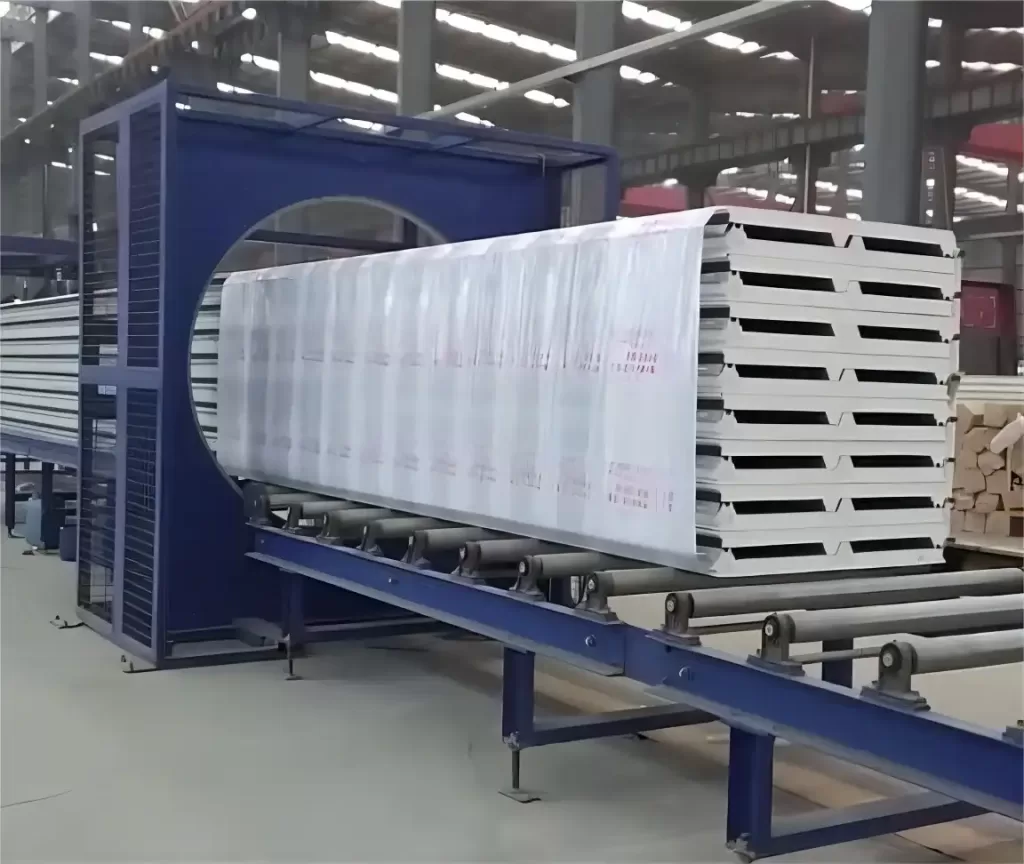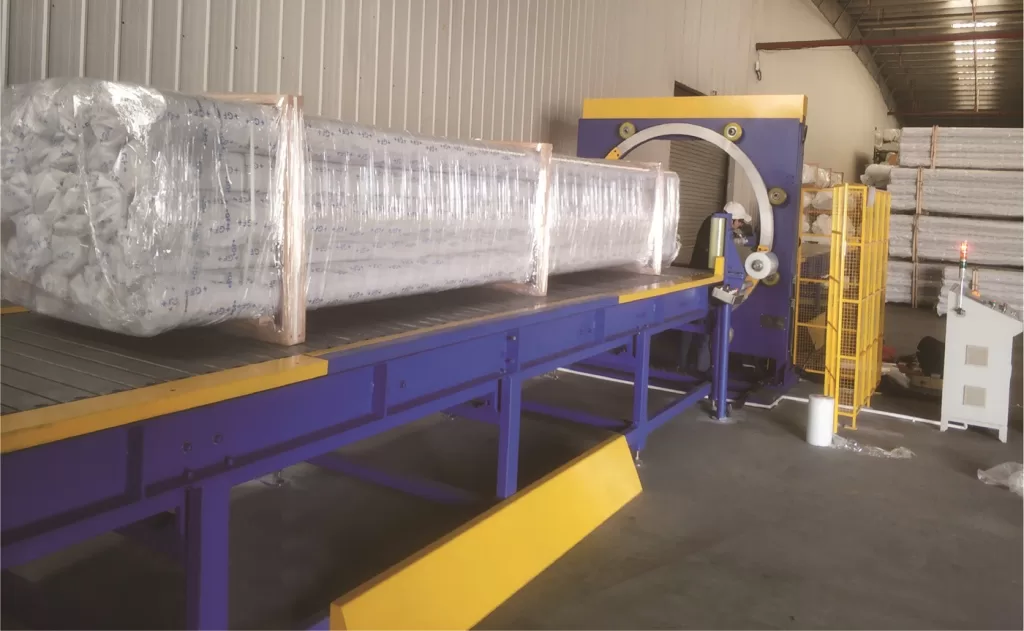Mastering Load Stabilization: A Guide to Orbital Stretch Wrapping and Strapping Systems
Securing long, bulky, or irregularly shaped products for transport presents unique challenges in manufacturing and distribution. Traditional pallet wrapping methods often fall short, potentially leading to load instability and product damage. Orbital stretch wrapping machines, sometimes complemented by strapping systems, offer a specialized solution for effectively unitizing these difficult loads.
Explore options for Orbital stretch wrapping machine and strapping machine systems designed for various industrial applications.
What is an Orbital Stretch Wrapper?
An orbital stretch wrapper, also known as a horizontal wrapper, operates differently from conventional turntable or rotary arm machines. Instead of rotating the load, an orbital wrapper features a large ring or wrap head that revolves around the stationary or slowly conveying product. This ring carries the stretch film roll and dispenser. As the ring orbits, it dispenses the film, applying it horizontally around the length of the product bundle.
This method is particularly effective for items such as:
- Pipes, tubes, and extrusions
- Lumber and timber bundles
- Doors and windows
- Textile rolls
- Assembled furniture or components
- Other elongated or non-palletized items
The following video demonstrates a typical orbital wrapping process integrated with strapping:
How Orbital Stretch Wrapping Works: The Process
While specific machine designs vary, the fundamental orbital wrapping process generally involves these steps:
- Load Infeed: The product or bundle is placed onto the machine's conveyor system, either manually or automatically.
- Film Application Start: As the load enters the wrapping zone, the orbital ring begins its rotation. The film tail is automatically captured or applied to the load.
- Orbital Wrapping: The ring continuously revolves around the load as it moves through the machine (or while stationary, depending on the model), applying overlapping layers of stretch film along its length. Film tension and overlap are precisely controlled.
- Film Cut and Seal: Once the entire length is wrapped, the machine automatically cuts the stretch film and secures the tail, often using a heat or wipe-down mechanism, ensuring a tight finish.
- Load Outfeed: The fully wrapped bundle exits the machine via the outfeed conveyor.

cross horiozntal orbital stretch wrapper six side Key Operational Benefits of Orbital Stretch Wrapping
Implementing orbital stretch wrapping technology offers significant advantages, particularly for specific product types:
Enhanced Load Containment and Protection
The 360-degree horizontal wrap provides exceptional load stability, tightly bundling individual items together and preventing shifting during handling and transit. Precise servo control over film tension ensures a secure wrap without crushing the product or creating film tears. This significantly reduces the risk of damage compared to manual methods or less suitable automated systems. Some systems allow for wrapping across all six sides for a fully sealed package, offering enhanced protection against environmental factors like dust and moisture.
Versatility for Non-Standard Loads
Orbital wrappers excel where turntable wrappers struggle. Their ability to handle very long, heavy, or irregularly shaped items without needing a pallet makes them ideal for industries dealing with materials like lumber, piping, carpets, or large extrusions.
Optimized Material Usage
Advanced film delivery systems with controlled pre-stretch and tension regulation minimize stretch film consumption. Applying the right amount of force ensures load security while avoiding excessive material use, leading to cost savings and reduced environmental impact through less plastic waste.

Increased Throughput and Automation
Automated orbital wrapping significantly increases packaging speed compared to manual wrapping or banding. Continuous operation, fast cycle times (some machines wrapping 50-100 loads/hour), and integration with production lines streamline the end-of-line packaging process, boosting overall operational efficiency.
Improved Workplace Safety
Automating the wrapping process eliminates the ergonomic risks associated with manually handling heavy stretch film rolls and repetitively wrapping large or awkward loads. This reduces the potential for strains, sprains, and other musculoskeletal injuries, contributing to a safer work environment and lowering associated costs like workers' compensation claims. Learn more about packaging safety standards from PMMI.
Integrating Strapping Machines
While orbital stretch wrap provides excellent containment, strapping machines often work in tandem to enhance load security further. Strapping can be applied:
- Before Wrapping: To initially bundle loose items (like individual pipes or boards) into a more manageable unit before stretch wrapping.
- After Wrapping: To add reinforcement, particularly for very heavy or unstable loads, preventing potential expansion or separation under the stretch film.
Horizontal or vertical strapping machines can be integrated inline with orbital wrappers to create a fully automated bundling and unitizing system tailored to specific product requirements.
Operational Considerations
Footprint and Integration
While capable of handling large loads, modern orbital wrappers are often designed with a relatively compact footprint, allowing for integration into existing production lines without extensive reconfiguration. Consider conveyor height, line speed, and control system compatibility when planning integration.

Durability and Maintenance
Industrial orbital wrappers are typically built with heavy-duty components designed for continuous operation in demanding environments. Robust construction ensures longevity and reliability. Regular preventative maintenance, focusing on the film carriage, ring drive, and cutting/sealing mechanisms, is crucial for minimizing downtime and ensuring consistent performance.
Film Selection
Choosing the appropriate type and gauge of stretch film is critical for optimal performance and cost-effectiveness. Factors like load weight, shape, stability, and required containment force influence film selection. Consult with film suppliers and machine manufacturers for recommendations.

Conclusion
Orbital stretch wrapping machines, often integrated with strapping systems, provide a highly effective and efficient solution for stabilizing and protecting long, bulky, or non-standard loads. By applying stretch film horizontally around the product, these systems deliver superior load containment, optimize material usage, increase throughput, and enhance workplace safety compared to manual methods or traditional pallet wrapping. Understanding the operational principles and benefits allows manufacturers and distributors to leverage this technology for improved packaging quality, reduced damage rates, and streamlined end-of-line automation.